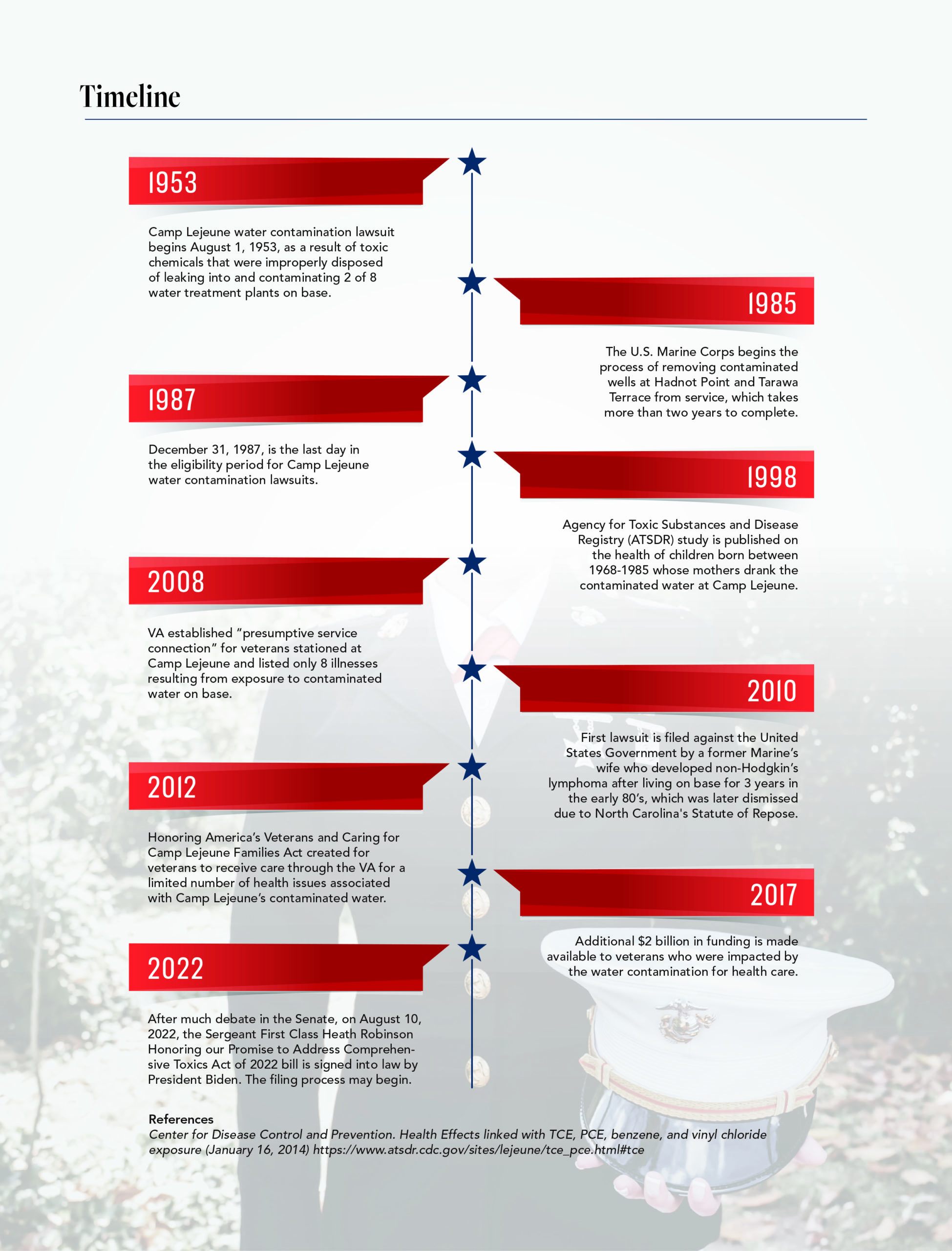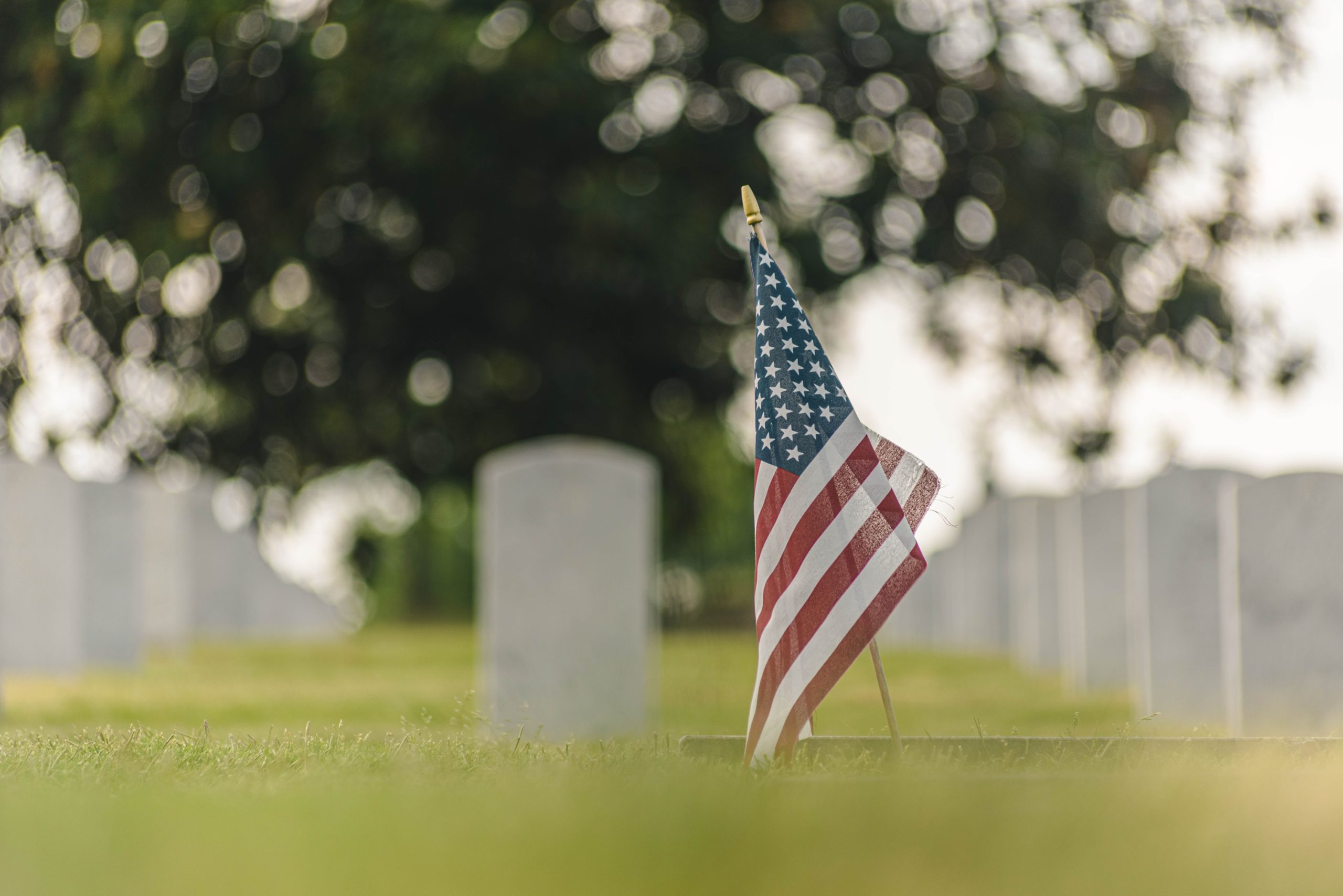by Ben Whitley
Scientific and medical evidence has shown that for over a 35-year period, from 1953 to 1987, Marine Corps Base Camp Lejeune’s drinking water was contaminated with toxic chemical compounds such as trichloroethylene (TCE), benzene, perchloroethylene (PCE), vinyl chloride and others. This water used for drinking, bathing, cooking and cleaning on the base was dangerously contaminated, but the military families consuming the water were never warned about its toxicity. As a result, many families suffered miscarriages on base or developed deadly diseases later on. For years, the federal government denied responsibility for the high rates of serious illnesses experienced by those who lived or worked at Camp Lejeune. The generational effects of this toxic exposure are still felt today. Most exposed victims are still being diagnosed with cancer, Parkinson’s and other deadly diseases decades after the initial exposures.
In 1953, the water treatment system at the on-base housing development called “Hadnot Point” was contaminated by leaking underground storage tanks and other waste. From then until the 1980s, even more on-base water treatment systems were affected. In 1982, while testing nearby water systems for contaminants, it was discovered that two of the eight water treatment plants on base were contaminated with specific volatile organic compounds (VOCs). Still, it wasn’t until 1984 that the water supply wells at Hadnot Point and a newer development, “Tarawa Terrace,” were sampled. Perchloroethylene was detected at levels well above the current EPA maximum contaminant level of 5 parts per billion. This began an environmental cleanup program by the United States Marine Corps to address toxins in water wells and other sites on base known to be contaminated. After this, the lengthy process of removing the contaminated wells was initiated.
In 1997, the Agency for Toxic Substances and Disease Registry, under the Centers for Disease Control, identified many health hazards from exposures to the water at Camp Lejeune. It is estimated that over more than 30-year period, over 1 million people were affected by the water contamination on base. Those affected include military members, families living on base and civilian employees working there. Sadly, many infants and babies in utero were also harmed by the toxins from their mothers ingesting the contaminated water.
Under newly passed legislation, the “Honoring Our PACT Act,” (which contains the Camp Lejeune Justice Act), veterans, veteran families and some civilian employees are now eligible for compensation. This legislation is crucial to affected individuals and families because they will finally be able to bring their claims against the Federal Government after many roadblocks and false starts over the years. These lawsuits are entirely separate from a VA disability filing based on exposure to toxic water. We hope these new lawsuits will go above and beyond what was previously available to these injured claimants.
North Carolina’s Statute of Repose
The North Carolina Statute of Repose for toxic exposure is ten years. This means you have only ten years after the harmful exposure to bring a claim for any injuries that result. The trouble with North Carolina’s Statute of Repose as it relates to the Camp Lejeune toxic water is that the exposures occurred decades ago, back in the 1950s-1980s, which traditionally made bringing a successful claim impossible. Also, many people got sick after the window of repose had passed. Bringing such a claim was “barred,” until the new Honoring Our PACT Act became law, which does away with the statute of repose, therefore opening the government back up to lawsuits from decades-old toxic exposures.
Who Qualifies for a Claim Against the Camp Lejeune Water Contamination?
Previously, only affected veterans could bring a claim for their injuries from toxic water exposure while living and working on base. Now, this new legislation opens up possibility for a new lawsuit and allows families and civilian employees to bring claims, so long as two criteria are met:
- Presence on base for at least 30 days between August 1, 1953, and December 31, 1987, and a
- Qualifying diagnosis or diagnoses
This new legislation also includes surviving family members of a claimant who may already be deceased but fits the criteria and those who were affected in utero while their mother was on base for the specified time.
What Cancers are Associated with the Camp Lejeune Water Contamination?
Toxic chemicals found in the water at Camp Lejeune from the 1950s to 1980s have been linked to a number of serious health concerns, including cancers. Multiple types of cancer have been associated with prolonged exposure to these toxic chemicals, including:
- Kidney cancer
- Non-Hodgkin’s lymphoma (a cancer of the lymphatic system)
- Liver cancer
- Bladder cancer
- Multiple myeloma (a cancer of the body’s plasma cells)
- Leukemia (a cancer of the blood)
- Brain cancer
- Lung cancer
- Thyroid cancer
- Esophageal cancer
What Other Illnesses are Associated with the Camp Lejeune Water Contamination?
Though cancer is one of the major concerns among those suffering from this repeated toxic exposure, many other illnesses are linked to the toxic compounds found in the water sources on-base. Other potential health concerns include:
- Parkinson’s disease
- Nephrotoxicity (damage to the kidneys)
- Scleroderma
- Aplastic anemia (a condition where the bone marrow stops producing enough blood cells)
- Myelodysplastic syndromes (MDS) (abnormalities in the body’s blood cell production)
- Hepatic steatosis (fatty liver syndrome)
- Cardiac defects
- Neurobehavioral disorders
- Fertility issues and miscarriage
In addition to ingesting contaminated water, in-utero exposure to contaminated water has led to a wide range of birth and fertility issues, including high rates of childhood cancer, birth defects and stillbirths. There is a dedicated cemetery in Jacksonville, NC, called “Baby Heaven,” due to the high volume of children and infants buried over the decades-long presence of deadly toxic water at Camp Lejeune.
What Toxic Chemicals Were Found in the Water at Camp Lejeune?
Trichloroethylene (TCE)
Otherwise known as TCE, this liquid is used primarily for cleaning metal parts and as a dry-cleaning solvent. A one-time exposure to TCE can cause symptoms such as headaches and dizziness, but prolonged exposure in low doses, such as those at Camp Lejeune, increases the risk for severe health conditions developing. A dry cleaner near Camp Lejeune is suspected to be the primary cause of TCE contamination by incorrectly disposing of these chemicals.
Benzene
This toxin is commonly found in everything from gasoline fumes, smoke, plastics and dyes. Low-level benzene exposure causes minimal symptoms, but long-term benzene exposure is a known carcinogen. It can affect the bone marrow and red blood cells, causing cancer. It is believed benzene made its way into the Camp Lejeune water supply through underground storage tanks that leaked into the soil and water.
Perchloroethylene/Tetrachloroethylene (PCE)
PCE is a chemical similar to TCE and is often used as a dry-cleaning chemical. It is a liquid that is frequently used to remove grease, but when ingested, it can cause harmful medical conditions. This toxic chemical was the primary chemical found in the water tested at one of the water treatment plants at Camp Lejeune. The dry-cleaner nearby to Camp Lejeune is also expected to be the primary cause of PCE contamination by incorrectly disposing of these chemicals, allowing them to contaminate the local water supply.
Vinyl Chloride
Vinyl Chloride is a manufactured gas that is used to produce PVC pipes, wire coatings, vehicle upholstery and more. High levels of this toxin can cause damage to the liver, lungs and kidneys. PVC is commonly used in industrial and military products. The levels of vinyl chloride were too high, as it is a carcinogen.
Link Between Toxic Chemicals and Health Problems
Exposure to toxic chemical substances can result in different effects, and whether these effects are long-term can depend on factors such as:
- When you are exposed (in utero, childhood, etc.)
- How much you are exposed to
- How long you are exposed
- How you are exposed (drinking)
- What your personal traits and habits are
Because of this, not everyone who is exposed to toxic chemicals will develop health problems (Centers for Disease Control and Prevention, 2014). However, studies conducted have shown a link between chemicals, such as those that contaminated drinking water at Camp Lejeune, and certain diseases. Therefore, later development of these diseases can be attributed to prolonged toxic chemical exposure on the Marine Corps base.
Legal History
A woman in Iowa became the first person to bring a civil case against the United States government in 2010 due to exposure to contaminated water at Camp Lejeune. Laura Jones lived at Camp Lejeune from 1980-1983 with her Marine husband and was years later diagnosed with non-Hodgkin’s lymphoma, which she attributed to the contaminated drinking water on base. North Carolina is the only state with a statute of repose that bars anyone from bringing a claim more than ten years after the toxic exposure for any injuries that result. In Jones’ case, like many others, she was not diagnosed with the illness until after that time had already passed, which can be the case with many cancers and diseases caused by toxic exposure. Because of this, the Navy’s request to dismiss the case was denied by a federal judge, and it was ruled that her lawsuit was filed on time and that the court had jurisdiction. Over the next few years, many victims of the toxic water contamination at Camp Lejeune followed suit. They filed lawsuits against the government resulting from their toxic exposures to contaminated water on the base. However, in 2016 a Federal Judge dismissed the over 800 lawsuits as a part of a multidistrict litigation due to North Carolina’s Statute of Repose and victims of the Camp Lejeune water contamination have had a long journey to recovery and financial compensation since.
The Honoring our PACT Act
The Sergeant First Class Heath Robinson Honoring our Promise to Address Comprehensive Toxics Act of 2022, or “PACT Act” as it is widely known, comes as a relief to many families affected by toxic substance exposure during military service. The PACT Act is a bill that addresses health care, resources and other matters for veterans who were exposed to these toxic substances for prolonged periods of time during their service. This bill is the first of its kind in the nation’s history. It offers healthcare and benefits to veterans and others exposed to toxic substances. One of the priorities of the PACT Act of 2022 was to add 23 toxic exposure-related conditions to the VA’s list of illnesses covered. The legislation is named in honor of SFC Heath Robinson, who served as an Army National Guardsman and, after developing rare cancer that is caused by prolonged exposure to toxic substances, lost his life in 2020. His family has been devoted to ensuring other veterans and their families suffering from toxic exposure can receive the health care and benefits they deserve.
Since Laura Jones’ initial suit filed in 2010, victims have been struggling to receive benefits and compensation from the federal government for illnesses caused by their exposure to contaminated drinking water. In 2012, President Barack Obama signed the Honoring America’s Veterans and Caring for Camp Lejeune Families Act which gave veterans affected by the toxic water contamination options to receive health care more easily through the VA. The requirements were similar. However, a far smaller list of illnesses was associated, and only veterans were eligible. In 2017, an additional $2 billion was made available, but still only included a limited list of illnesses for veterans.
Contained within the PACT Act is the Camp Lejeune Justice Act, which now makes it possible for not only veterans but any military family members and civilians who meet the criteria of being on base for 30 cumulative days between August 1, 1953, and December 31, 1987, who were diagnosed with one of the specified cancers or illnesses to file a lawsuit against the federal government. The new bill includes almost $300 billion in financial benefits for veterans suffering from illnesses caused by multiple types of toxic exposures, with over $2 billion for Camp Lejeune victims alone.
What are my Legal Rights if I was Affected by Toxic Water at Camp Lejeune?
As of August 10, 2022, the date the Honoring our PACT Act was signed into law, veterans, their families and exposed civilian employees are able to bring claims for personal injury and wrongful death caused by the toxic exposure. An individual claimant must show only two things: (1) that they worked or lived on-base for at least 30 cumulative days between August 1, 1953, and December 31, 1987, and (2) that
they have been diagnosed with one or more qualifying diseases, illnesses, defects or death. (Surviving family members may bring claims on behalf of a deceased claimant; babies who were in-utero on base at the time of the water contamination may also have a claim.)
How Long do I Have to File a Case?
Once the legislation became law on August 10, 2022, claimants have only two years from that date to file their claims before the window to do so closes. Alternatively, claimants will have 180 days after the administrative agency denies their claim to file. Because this window is only open for a short period, it is important not to delay investigating or pursuing your potential claim.
What if I Previously Filed for VA Benefits for Health Conditions Related to Camp Lejeune Water Contamination?
Individuals who were previously granted health and disability benefits for illnesses related to toxic water exposure at Camp Lejeune may have any ultimate award or compensation “offset” or reduced based on prior payments or awards received for toxic water disability.
Damages for Toxic Water Exposure
As a result of the injury or disease you have suffered because of toxic water exposure at Camp Lejeune, you may be entitled to compensation for:
- Medical expenses
- Lost wages
- Loss of earning potential
- Out-of-pocket expenses
- Pain and suffering
- Emotional distress
- Disability
- Loss of society and companionship
The damages to be awarded from this lawsuit are separate from benefits one may already receive through the VA for service-connected disability from the toxic water at Camp Lejeune. This lawsuit will NOT affect one’s ongoing VA or government benefits.
The Importance of Hiring a Local Lawyer
Now that the Camp Lejeune Justice Act is law, thanks to the PACT Act, thousands and thousands of stories can be told to a jury. These are going to be uniquely North Carolina cases. North Carolina Law will apply in a North Carolina Federal Court House with North Carolina Judges and juries. The Eastern District of North Carolina has been given exclusive jurisdiction over the claims and is an adverse jurisdiction to multiple special appearances.









Leave A Comment